If you’re losing hours every week to tasks that don’t move your practice forward, you’re not alone. Many optometrists find themselves overwhelmed, not because they aren’t working hard, but because too much of their day is consumed by repetitive, low-impact tasks. These hidden time leaks can quietly drain productivity, revenue, and your peace of mind.
Let’s break down the five biggest culprits and what to do about them.
1. Answering Every Phone Call Yourself (or Letting Staff Multitask It)
Why it’s a problem
It’s tempting to see every phone call as important, and many of them are. But when doctors or front desk staff constantly stop what they’re doing to answer calls, patient flow suffers. Calls interrupt in-progress check-ins, disrupt billing tasks, and create stress when multiple lines ring at once.
Staff members often try to multitask, juggling in-person interactions while putting callers on hold, scribbling half-notes, or missing important details. The result? Frustrated patients, disorganized records, and an overwhelmed team.
What to do instead
Start by analyzing your call volume. When are most calls coming in, and what types of requests dominate? With that data, set clear expectations for when staff should prioritize calls versus in-person needs. Use a call tree to route routine inquiries (like hours or directions) to voicemail or automated messages. Reserve live call handling for new patients or time-sensitive matters.
You can also stagger front desk shifts to ensure someone is always available to answer calls without splitting focus. Finally, consider rotating responsibilities or delegating after-hours voicemails to one designated staff member, so your team doesn’t start every morning overwhelmed by catch-up work.
These steps will not only free up your staff to focus on patients in front of them, but they’ll also improve phone etiquette and ensure calls don’t turn into chaos.
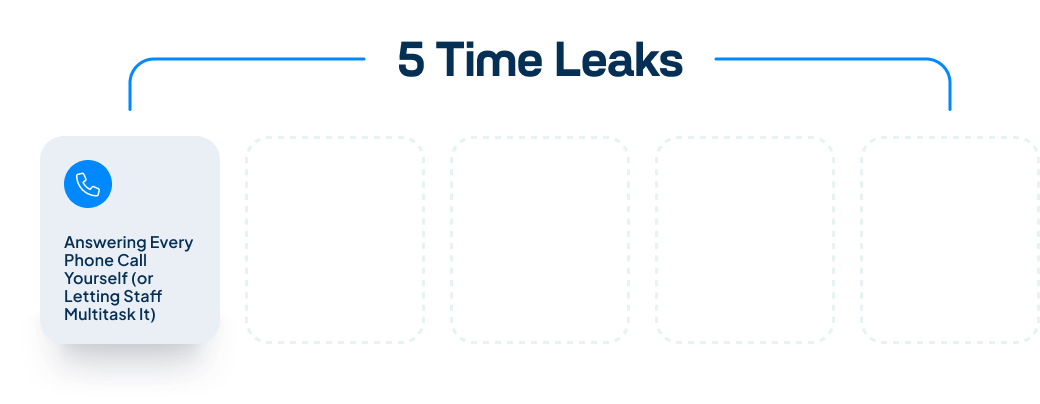
2. Chasing Down Missed Appointments and Late Cancellations
Why it’s a problem
Every unfilled appointment slot represents lost revenue, and if it becomes a pattern, it starts to erode your bottom line. Worse, the process of managing no-shows1 and last-minute cancellations is often disorganized.
You or your staff may spend hours playing phone tag with patients, scrolling through schedules to rebook gaps, or completely missing the opportunity to refill those times. Over time, it becomes a drain on morale and momentum.
What to do instead
Start by reducing preventable no-shows. Implement an automated reminder system that sends out texts or emails 24 to 48 hours in advance. These messages should make it easy for patients to confirm, reschedule, or cancel, so you get notice early enough to act.
For the inevitable late cancellations, build a waitlist protocol. Keep a running list of patients who want earlier appointments or flexible availability, and task a team member with managing that list. Whenever a slot opens, they can quickly fill it.
Lastly, designate a regular time, maybe every Friday afternoon, for one staff member to conduct patient recalls. These quick check-ins with lapsed patients can revive appointments and maintain continuity of care. It’s also an opportunity to re-engage patients who may have drifted away after a single visit.
By systematizing this process, you transform chaos into consistency, and you stop letting time go to waste in the cracks of your schedule.
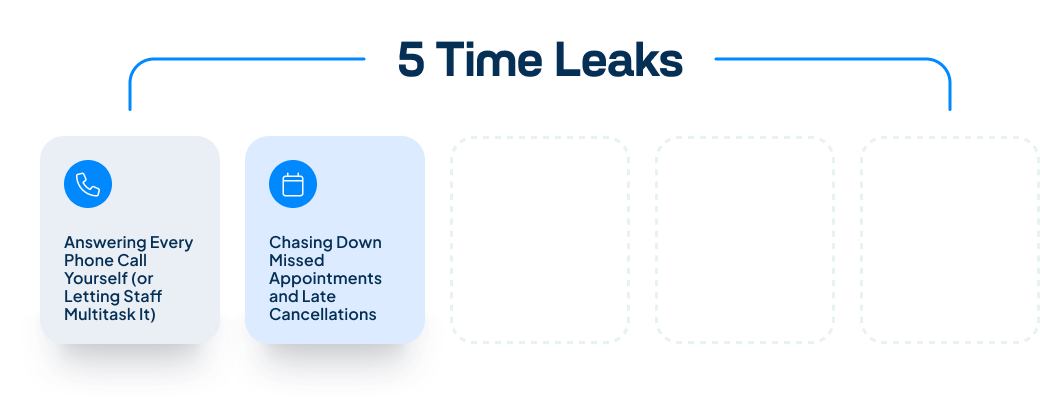
3. Managing Emails, Insurance Verifications, and EHR Input
Why it’s a problem
Not all time drains are visible. Behind the scenes, many optometrists and their staff spend hours each week buried in emails, manually entering patient data into the EHR, or verifying insurance before appointments. These tasks are critical, but they don’t always feel urgent, which makes them easy to procrastinate. Unfortunately, when ignored, they pile up fast and lead to billing errors, denied claims, and rushed documentation.
What to do instead
Start by leveraging the technology you already have. Most EHR platforms come with automation features that can speed up charting, pre-fill visit templates, and auto-sync billing codes. Take time to explore these capabilities or have a team member become your “EHR champion” who can master and train others.
Next, standardize email responses. If your staff is constantly fielding the same patient questions (billing, office hours, insurance accepted, etc.), create templated replies that save time and reduce response inconsistencies.
Lastly, carve out protected admin blocks in your weekly schedule. Instead of letting insurance verifications or email replies bleed into patient care hours, assign specific times where a staff member focuses solely on back-office tasks. Whether it’s 90 minutes every morning or one afternoon a week, batching admin work allows for better concentration and fewer errors.
With a few intentional systems, you can reclaim hours every week—and eliminate the stress of always “catching up.”
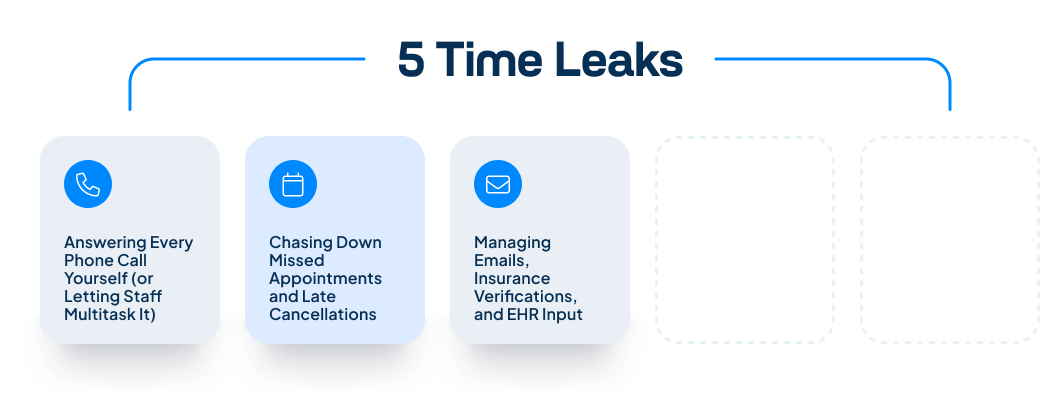
4. Doing End-of-Day Wrap-Ups and Follow-Ups Alone
Why it’s a problem
If your workday doesn’t end when the last patient leaves, you’re not alone. Many practice owners find themselves staying late to finish documentation, return calls, clarify billing, or follow up on lab results.
This solo scramble not only eats into your personal time, but it also sets you up for burnout and reduces the energy you bring into the next day. Important patient touchpoints may get delayed or skipped altogether.
What to do instead
Make end-of-day routines a team process, not a solo burden. Assign wrap-up duties to one staff member on a rotating basis, so everyone shares responsibility for finalizing the day. This could include calling patients about lab results, clearing voicemails, or ensuring tomorrow’s schedule is prepped.
Create an end-of-day checklist that outlines exactly what needs to be closed out. Checklists reduce decision fatigue and speed up the process by creating repeatable habits.
Finally, push non-urgent follow-ups to the next morning’s admin block. If you already have a system in place (as discussed in Section 3), batch calls or email responses during that time instead of tackling them when you’re already exhausted.
These small process shifts can reduce after-hours stress and give you back your evenings, without sacrificing patient care.
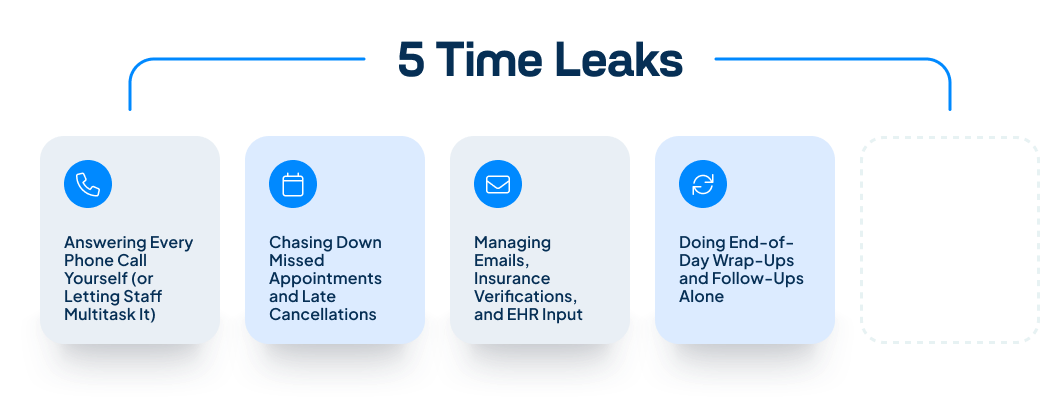
5. Training, Retraining, and Replacing Front Desk Staff
Why it’s a problem
Hiring and training front desk staff is one of the most time-consuming responsibilities in any practice. Every time a team member leaves, it creates a ripple effect: disruptions in patient service, gaps in scheduling, and countless hours spent on onboarding someone new. Even when training is outsourced, you still have to monitor progress, answer questions, and correct mistakes, often while still seeing patients.
What to do instead
The key to reducing the chaos of turnover is creating consistency in your onboarding. Document your front desk processes into a repeatable Standard Operating Procedure (SOP). Use step-by-step video tutorials that walk through tasks like insurance verification, patient intake, or EHR navigation. These resources reduce your active training time and ensure that every new hire gets the same information, the same way.
It’s also smart to cross-train team members. If only one person knows how to confirm appointments or run insurance, your practice becomes vulnerable to sudden gaps. With cross-training, team members can cover each other smoothly without a drop in productivity.
Lastly, use hiring scorecards to assess candidates more objectively. Define your must-have skills and traits before the interview process. That way, you reduce gut-based decisions and focus on long-term fit.
With a repeatable system and strategic cross-training, you spend less time reacting to turnover, and more time building a resilient front desk team.
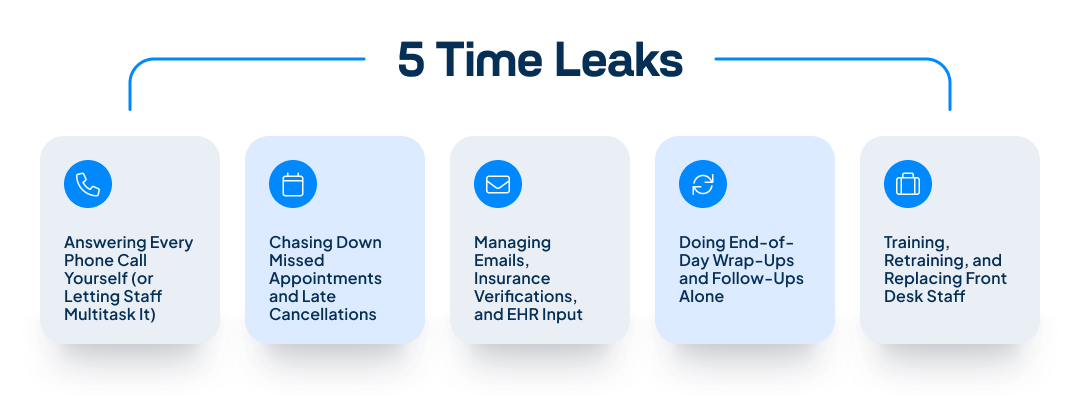
What Actually Solves All 5 Time Leaks? An Optometry Virtual Assistant
Even the most efficient internal systems have their limits. As your growth accelerates, your team can only handle so much before feeling stretched too thin. That’s where a skilled Optometry Virtual Assistant (VA) comes in, helping you streamline operations and keep your practice moving forward without the time drain.
Teem’s optometry-specific VAs are real people (not bots) who’re trained in handling medical administrative tasks. They merge directly into your workflow, whether that’s your phones, EHR, insurance software, or follow-up processes. The best part? There’s no complex onboarding or tech learning curve.
Instead of hiring, training, and managing new in-house staff, Teem VAs integrate quickly and start adding value in days. They help answer calls, confirm appointments, follow up on labs, verify insurance, and manage your inbox, freeing up your in-house team to focus on patient experience and revenue-generating tasks.
With a virtual assistant built for optometry admin, you get more done without adding stress, hours, or overhead. It’s a true plug-and-play staffing solution for all five of the time leaks we’ve discussed.
Final Thoughts: Reclaim Your Time and Refocus on Your Patients
Every optometry practice has hidden time leaks. But when those leaks become routine, they start stealing your energy, your evenings, and your ability to grow. If you’re constantly catching up instead of moving forward, it’s time to stop patching holes and start building better systems.
You don’t need more hours in the day. You need smarter support.
Let Teem help you plug those leaks. Our expert virtual assistants integrate seamlessly into your workflow, so you can finally get back to doing what you do best: serving your patients.
Take back your lost workweek by reaching out to Teem HERE.



